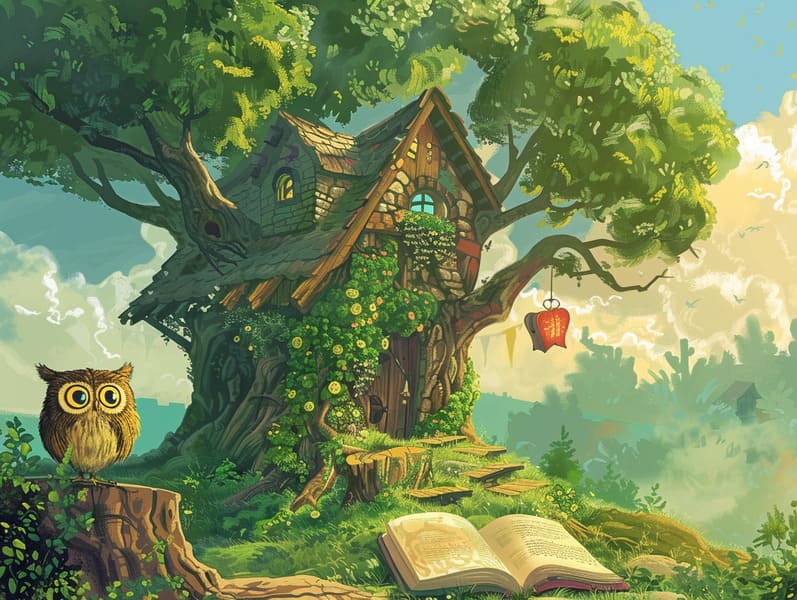
Fairy tales have ancient roots. These narratives have been told from one generation to the next millennia before they were ever recorded. They developed from a variety of cultures, including African traditions. They were initially transmitted among grown-ups, often carrying themes and messages relevant to the societal norms and beliefs of the time.
The Brothers Grimm, Jacob and Wilhelm (the Grimm brothers), were among the first to assemble many of these beloved narratives. Their collection, "Grimm's Fables," included classics like "The Little Glass Slipper," "The Bread Crumb Trail," and "Little Snow White," which have since become pillars in the world of children's fairy tales. Similarly, H. C. Andersen's enchanting fairy tales, such as "The Little Mermaid," and "The Little Duckling," have captured hearts worldwide, securing their place in the pantheon of beloved fairy tales.
Despite their ancient origins, these tales remain as significant as ever, especially as kids' bedtime tales. These enchanting tales are now available in diverse formats, including colorful picture books, captivating animations, and online fairy tales.
Their ongoing significance can be connected to several fascinating points:
Ethical Lessons: Timeless fairy tales often whisper important moral lessons. Narratives like "The Shepherd Boy and the Wolf" teach the value of honesty, while "The Race of the Tortoise and the Hare" stress the traits of resolve and modesty. These narratives offer the young clear distinctions between ethical and unethical, helping to shape their moral compass in a mild yet profound way.
Compassion and Knowledge: Fairy tales frequently portray beings facing obstacles and hardships, stimulating young listeners to comprehend with their struggles and celebrate their triumphs. For instance, "Beauty and the Beast" teaches us the virtue of seeing inner beauty to recognize the inner spirit of a character, strengthening perception and appreciation.
Cultural Comprehension: Many classic fairy tales are saturated in the cultural contexts from which they grew. Discovering these fairy tales can provide captivating looks into different beliefs, developing a sense of global awareness and discernment.
Inventiveness and Fantasy: The mythical elements in ancient fairy tales—magical beings—promote children’s inventiveness. These tales guide readers to extraordinary realms, revitalizing imaginative thinking and a sense of curiosity that lasts a lifetime.
Classic fairy tales are not only fascinating but also enlightening. They work as charming tools in enhancing various cognitive and affective skills in the young. When traditional fairy tales are told out loud, they strengthen speech development by showing new phrases and elaborate sentence structures. This practice also advances listening skills and focus, as little ones keep up with the story, excited to see what happens next.
Furthermore, discussing the themes and characters of fairy tales can advance cognitive skills and critical thinking. Kids are instructed to recognize patterns, foresee events, and catch on to cause and effect. These explorations also further little ones reveal their thoughts and feelings, enhancing their emotional intelligence.
In today’s cyber age, the proliferation of digital fairy tales has made these narratives more available than ever. Websites and these guys web apps provide huge assortments of old fairy tales that can be browsed or played anytime, anywhere. Fairy tales read out loud are particularly favored, extending an enjoyable way for children to appreciate these delightful tales. Read-aloud books and read-aloud videos take characters and settings to life, often complemented by whimsical sound effects and songs that boost the story adventure.
The persistent attraction of traditional fairy tales lies in their ability to alter to present days while staying true to their main lessons. Contemporary reinterpretations of these tales often introduce more different figures and modern settings, making them meaningful to today’s audience. However, the main ideas of heroism, benevolence, and justness remain unchanged, continuing to move listeners of all ages.
Fairy tales also offer a sense of calm and knowability. They afford a structured narrative with a plain beginning, middle, and end, often concluding with the culmination of conflicts and the triumph of virtue over vice. This certainty can be comforting for young readers, gifting a sense of unwaveringness in an unpredictable world.
Classic fairy tales continue to entrance and train new generations, maintaining their beauty and impact in modern society. As children's night stories, they confer a perfect blend of wonder and wisdom, cultivating moral values, empathy, and creativity. The prevalence of online fairy tales and the well-liked nature of fairy tales spoken guarantee that these old narratives remain obtainable to new generations.
By retaining and narrating these stories, we continue to esteem the rich tapestry of storytelling and cultural heritage. Whether you are perusing a vibrantly illustrated book, seeing a online collection, or listening through an audio story, the appeal of traditional fairy tales is always within reach. These tales illustrate of the unending spell of tales and its ability to connect us across eras and regions.
If you are experiencing a richly illustrated book, perusing a online library, or hearing an sound book, the fascination of children's fairy tales is always within reach.
These narratives highlight of the unending force of narratives and its ability to bond us across centuries and lands, forging a link that captivates and teaches alike.